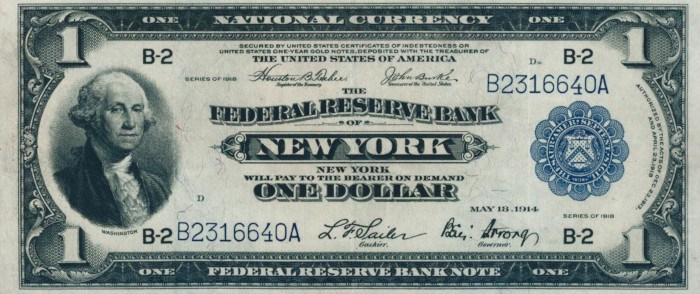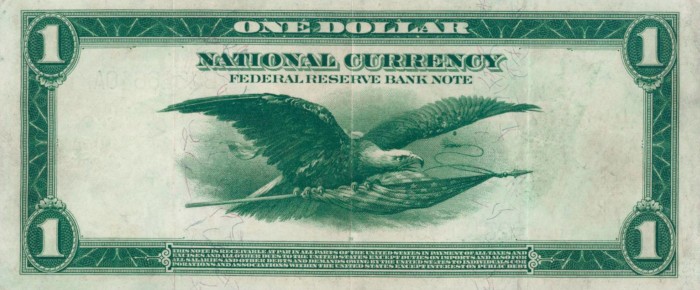The 1918 one dollar bills can be valuable depending on their condition. Keep reading to learn more about these bills.


This bill is nicknamed the "Green Eagle Note". On the obverse side of the bill the design features a portrait of George Washington. The reverse side of the bill is printed in green and white and the design features a bald eagle. The bald eagle is shown in flight carrying an American flag.
Specifications
| Denomination: | $1.00 USD |
| Type: | Federal Reserve Note |
| Portrait: | George Washington |
| Series: | One: 1918 |
Value
The value will mainly depend on the bill's condition. Star notes do not exist for this series.
Most 1918 series $1 bills are worth around $115 in very good condition. In very fine condition the value is around $185. In extremely fine condition the value is around $235. Uncirculated bills with a grade of MS 63 can sell for around $575.
Rare Signature Varieties
There are a few rare signature varieties to look for. These rare varieties can sell for more money.
Bill No. F-741 is a notable rare signature variety. It has the treasury signatures of Elliot and Burke, and the bank signatures of Talley and Van Zandt. This note is worth around $175 in very good condition. In very fine condition the value is around $575. In extremely fine condition the value is around $750. Uncirculated bills with a grade of MS 63 can sell for around $4,500.
Bill No. F-735 is another notable rare signature variety. It has the treasury signatures of Teehee and Burke, and the bank signatures of Cook and Young. This note is worth around $250 in very good condition. In very fine condition the value is around $700. In extremely fine condition the value is around $1,200. Uncirculated bills with a grade of MS 63 can sell for around $4,250.
Note: Valuable bills should be placed inside large-size currency holders.
Grading System
Very good- A circulated note that has considerable wear to it. There might be one or two tears on the edge of the note. The note may be discolored, dark in appearance, or limp.
Very fine- A note that has been in circulation but not for a long time. The note is still relatively crisp. There may be some creases, folds, or light smudges.
Extremely fine- A note that shows small signs of having been in circulation. The note will be bright and it will have almost all of its original crispness. There might be one or two minor creases or folds but there are no stains, discolorations, or tears.
MS 63 choice uncirculated- A note that shows no signs of ever having been in circulation. The note still has its original crispness. The note is also well-centered.
Sources:
A Guide Book of United States Paper Money
See also:
